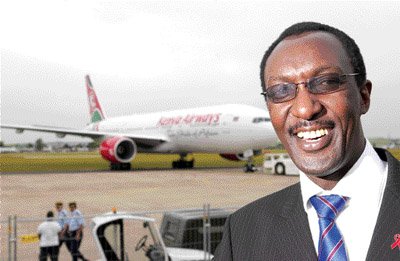During the recent Connectivity in Africa seminar in Nairobi, a conference organised by Embraer to examine developments in the continent’s airline sector, the plaudits for Kenya Airways and its much admired chief executive Titus Naikuni kept coming.
The SkyTeam carrier is seen by most industry observers in the region as a shining example of what can be achieved within sub-Saharan Africa, where the majority of carriers continue to struggle to gain momentum. It is privately-owned, profitable, growing and developing intra-African connectivity. And in Naikuni, it has an African leader blazing a trail at its helm. Such is the impression Naikuni has made, that long-time African aviation commentator Nick Fadugba at one point during the conference wished it was possible to replicate Naikuni so the continent had another ten of him.
Naikuni’s outlook is one of refreshing positivity. He urges the African industry not to cry over the dominance of European, and more recently, Gulf carriers on long-intercontinental routes into Africa – they hold nearly two-thirds of international capacity – and concentrate on the opportunities instead.
 |
|---|
Naikuni has been at the helm of Kenya Airways since 2003 |
His glass on liberalisation, long mired and little progressed in Africa more than a decade on from the supposedly landmark Yamassoukro Decision, is half full rather than empty. Look back eight years he says, when he took the helm of Kenya Airways, and the carrier had limited access to states like Rwanda and Uganda. “Now, out of the blue, the governments say they are open,” Naikuni says, noting for example it now flies three times daily to Rwanda.
“West Africa is not a problem. East Africa is still very protected, but it is slowly opening up and people are starting to understand the economic benefits of opening up,” he adds. “It is coming and I am very confident. I think there will be change. If you look at the political landscape, if you look at the change in leadership, it is coming.”
From The Archives |
|---|
Read the Airline Business cover interview from 2006with Titus Naikuni |
His confidence is evident in the airline’s actions. It has just struck a preliminary deal with Embraer to take up to 20 more Embraer 170/190s, largely to support a strategy of adding frequencies to existing routes as the continent’s skies gradually open up. The regional jets enable it to support existing services with additional frequencies at a lower seat capacity.
“We are trying to do more frequencies as airspace opens up. Our intention is to have the E-jets go into the market and give us higher frequencies and get the larger aircraft onto routes into Europe and Asia,” he explains.
The carrier will open seven new routes this year and another seven in 2012 – mostly intra-African – though new routes include Beirut and Jeddah in the Middle East. “The [intra-African] market is growing,” says Naikuni. “As we continue opening routes you are seeing growth in markets which never had service before.”
Its ambitions do not stop at intra-African connectivity. The airline has struck a preliminary deal to add lease a pair of Boeing 777-300ERs from late 2012, joining four 777-200s it already operates, to help develop new routes in Asia, notably India. These aircraft will be followed by the first of nine Boeing 787s, which are now scheduled to arrive in the last quarter of 2013.
It is also embarking on an expansion of its freighter operations. “We are getting a 747 freighter that is starting operations in October,” said Naikuni, adding it is also currently looking at adding two Boeing 737-400 freighters for this October as well.
The carrier’s expansion has also come at a profit. It has been profitable at a net level in four of the last five years – impressive for a carrier which faced unrest and political uncertainty in its own home market in 2008 after elections in the country. The improvement continued last year, Kenya Airways improving net profits to $44 million on revenues up nearly a fifth to $1.07 billion.
From The Archives |
|---|
 |
Look back at the 2009 Airline Business cover interview with another of Africa's aviation leaders, Eithiopian Airline chief executive Girma Wake |
What Kenya Airways has managed to achieve is to break the shackles that continue to constrain so many of its counterparts in sub-Saharan Africa. It is not alone. South African Airways and Ethiopian Airlines are both bigger in terms of revenues and, like Kenya Airways, have entered the alliance world – Ethiopian will follow SAA into Star Alliance later this year. South Africa’s Comair meanwhile has successfully developed a dual existence as both a British Airways franchise partner and low-cost carrier innovator through its Kulula unit.
But Kenya Airways has become something a poster child for those urging the region to embrace open skies and privatisation in the airline sector. Kenya Airways has been in private hands since 1996, and Naikuni believes more must follow for the continent to thrive.
“My advice is get out of state ownership, then that allows the next step. If the private sector operates, mergers are the only way forward for us,” Naikuni says.
And he believes the opportunity within the region should not be under-estimated. “We take a look at China with a 1.2 billion population and say what a market. We look at India with a 1 billion population and say what a market. Africa has a population of at least 900 million. It’s not a small market,” he says. “Look at the opportunity that is as large as India and maybe China and ask what is stopping us from unlocking that potential?”
Source: Airline Business























